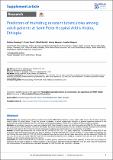| dc.contributor.author | Dessalegn, Muluken | |
| dc.contributor.author | Daniel, Ermias | |
| dc.contributor.author | Behailu, Sileshi | |
| dc.contributor.author | Wagnew, Maereg | |
| dc.contributor.author | Nyagero, Josephat | |
| dc.date.accessioned | 2021-08-24T10:39:30Z | |
| dc.date.available | 2021-08-24T10:39:30Z | |
| dc.date.issued | 11/26/2016 | |
| dc.identifier.citation | The Pan African Medical Journal. 2016;25 (Supp 2):5. | en_US |
| dc.identifier.issn | 1937-8688 | |
| dc.identifier.uri | http://repository.amref.org/handle/123456789/128 | |
| dc.description | © Muluken Dessalegn et al. The Pan African Medical Journal - ISSN 1937-8688. This is an Open Access article distributed under the terms of the Creative Commons
Attribution License (http://creativecommons.org/licenses/by/2.0), which permits unrestricted use, distribution, and reproduction in any medium, provided the original
work is properly cited. | en_US |
| dc.description.abstract | Introduction: the emergence of multi-drug resistant tuberculosis (MDR-TB) has become a major public health concern that threatens advances
made in global TB control efforts. Though the problem is prevalent, it did not receive major attention to generate supportive evidence for the
prevention and control of MDR-TB. The aim of this study was to identify predictors of MDR-TB in a national TB referral centre in Ethiopia.
Methods: an unmatched, case-control study was conducted at St. Peter Hospital to assess risk factors associated with MDR-TB. The study included
103 culture proven, MDR-TB patients referred to the hospital during the study period (cases) and 103 randomly-selected TB patients with confirmed
TB who turned negative after treatment (controls). Regressions analyses were used to determine the association of variables.
Results: the mean age among cases and controls was 30.5 (±9.26) and 34.73 (±11.28) years, respectively. The likelihood of having MDR-TB was
20.3 times higher among those who had a any previous history of TB treatment (AOR=20.3 [CI 5.13, 80.58]), 15.7 times higher among those who
had TB more than once (AOR=15.7 [CI 4.18, 58.71]) compared those who had once, 6.8 times higher among those who had pulmonary TB (AOR=6.8
[CI 1.16, 40.17]) and 16.1 times higher for those who had experienced treatment with a Category II regimen (AOR=16.1 [CI 2.40, 108.56]). HIV
infection was less common among cases than controls.
Conclusion: this study concluded that special attention should be given to patients with a history of the following: TB more than once, presence of
pulmonary TB, and used a Category II treatment regimen, as these were all determining factors for MDR-TB. Thus, this study urges the development
and implementation of well-planned and integrated strategies for MDR-TB control and prevention in Ethiopia. | en_US |
| dc.description.sponsorship | African Medical Research Foundation | en_US |
| dc.language.iso | en | en_US |
| dc.publisher | Pan African Medical Journal | en_US |
| dc.relation.ispartofseries | Strengthening health systems in communities: the experiences of AMREF Health Africa;Supp. 2: 5 | |
| dc.subject | MDR-TB | en_US |
| dc.subject | Predictors | en_US |
| dc.subject | Adults | en_US |
| dc.subject | Ethiopia | en_US |
| dc.subject | HIV | en_US |
| dc.subject | Tuberculosis | en_US |
| dc.title | Predictors of Multidrug Resistant Tuberculosis Among Adult Patients at Saint Peter Hospital Addis Ababa, Ethiopia | en_US |
| dc.type | Article, Journal | en_US |

